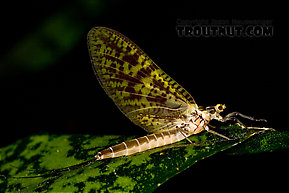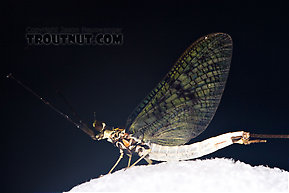Blog & Latest Updates
Fly Fishing Articles
Insects by Common Name


Shad Flies
Scientific Names
| Match | Scientific Name |
| Ephemera guttulata | |
| Brachycentrus appalachia | |
| Brachycentrus numerosus |
Like most common names, "Shad Fly" can refer to more than one taxon. They're previewed below, along with 3 specimens. For more detail click through to the scientific names.
Mayfly Species Ephemera guttulata
These are often called Shad Flies.
Ephemera guttulata's size, numbers, and hatching characteristics have made it a favorite of fly fishermen since the sport first came to our waters.
It is on par with the Midwest's Hexagenia limbata hatch for its ability to lure huge piscivorous (Piscivorous: Anything which eats primarily fish is a piscivore.) brown trout to eat insects at the surface once a year. The special charm of the Green Drake hatch is that it often takes place during pleasant Spring afternoons. It can be challenging because the large flies are easy for trout to inspect in the daylight and they feed very selectively, especially late in the hatch.
The Green Drakes are on the decline due to environmental degradation.
It is on par with the Midwest's Hexagenia limbata hatch for its ability to lure huge piscivorous (Piscivorous: Anything which eats primarily fish is a piscivore.) brown trout to eat insects at the surface once a year. The special charm of the Green Drake hatch is that it often takes place during pleasant Spring afternoons. It can be challenging because the large flies are easy for trout to inspect in the daylight and they feed very selectively, especially late in the hatch.
The Green Drakes are on the decline due to environmental degradation.
Female Ephemera guttulata (Green Drake) Mayfly Dun View 16 PicturesIt's about time I got a green drake on this site!
View 16 PicturesIt's about time I got a green drake on this site!
 View 16 PicturesIt's about time I got a green drake on this site!
View 16 PicturesIt's about time I got a green drake on this site!Male Ephemera guttulata (Green Drake) Mayfly Spinner View 12 PicturesThis spinner was the only member of its species I saw all night during an incredibly thick and tricky mixed hatch on Penn's Creek a few days before the real start of its famous green drake hatch.
View 12 PicturesThis spinner was the only member of its species I saw all night during an incredibly thick and tricky mixed hatch on Penn's Creek a few days before the real start of its famous green drake hatch.
 View 12 PicturesThis spinner was the only member of its species I saw all night during an incredibly thick and tricky mixed hatch on Penn's Creek a few days before the real start of its famous green drake hatch.
View 12 PicturesThis spinner was the only member of its species I saw all night during an incredibly thick and tricky mixed hatch on Penn's Creek a few days before the real start of its famous green drake hatch.See 1 more specimens...
Caddisfly Species Brachycentrus appalachia
These are sometimes called Shad Flies.
This is a "wind-shield wiper" hatch -- it slows traffic on the freeway which winds through the valleys of several famous trout streams in the Catskills, which have thick hatches of the Apple Caddis in the Spring.
The common name comes from the bright apple-green color of its abdomen.
The common name comes from the bright apple-green color of its abdomen.
Brachycentrus appalachia (Apple Caddis) Caddisfly Adult View 13 PicturesI captured this specimen in the same color as this photograph, during its egg-laying flight. The emergers are much lighter.
View 13 PicturesI captured this specimen in the same color as this photograph, during its egg-laying flight. The emergers are much lighter.
 View 13 PicturesI captured this specimen in the same color as this photograph, during its egg-laying flight. The emergers are much lighter.
View 13 PicturesI captured this specimen in the same color as this photograph, during its egg-laying flight. The emergers are much lighter.See 2 more specimens...
Caddisfly Species Brachycentrus numerosus
These are sometimes called Shad Flies.
In Caddisflies, Gary LaFontaine attributed the famous spring hatch on the Beaverkill (now known as the "Apple Caddis") to this species. After that publication, entomologists described that major hatch as a new species -- Brachycentrus appalachia.
Brachycentrus numerosus is probably still important in many locations.
Brachycentrus numerosus is probably still important in many locations.
Top 10 Fly Hatches
Top Gift Shop Designs
Eat mayflies.
Top Insect Specimens
Miscellaneous Sites
Troutnut.com is copyright © 2004-2024 Jason
Neuswanger (email Jason). See my FAQ for information about use of my images.
 privacy policy
privacy policy
